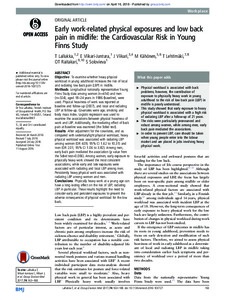Early work-related physical exposures and low back pain in midlife: the Cardiovascular Risk in Young Finns Study
Solovieva S; Lallukka T; Viikari-Juntura E; Raitakari OT; Lehtimäki T; Viikari J; Kähönen M
https://urn.fi/URN:NBN:fi-fe2021042716705
Tiivistelmä
Objective
To examine whether heavy physical workload in young adulthood increases
the risk of local and radiating low back pain (LBP) in midlife.
Methods
Longitudinal nationally representative Young Finns Study data among
women (n=414) and men (n=324), aged 18–24 years in 1986 (baseline), were
used. Physical heaviness of work was reported at baseline and follow-up
(2007), and local and radiating LBP at follow-up. Covariates were age,
smoking and body mass index. Logistic regression was used to examine the
associations between physical heaviness of work and LBP. Additionally,
the mediating effect of back pain at baseline was examined (the Sobel
test).
Results
After adjustment for the covariates, and as compared with
sedentary/light physical workload, heavy physical workload was
associated with radiating LBP among women (OR 4.09, 95% CI 1.62 to
10.31) and men (OR 2.01, 95% CI 1.06 to 3.82). Among men, early back
pain mediated the association (p value from the Sobel test=0.006). Among
women, early exposure to physically heavy work showed the most
consistent associations, while early and late exposures were associated
with radiating and local LBP among men. Persistently heavy physical work
was associated with radiating LBP among women and men.
Conclusions
Physically heavy work at a young age can have a long-lasting effect on
the risk of LBP, radiating LBP in particular. These results highlight
the need to consider early and persistent exposures to prevent the
adverse consequences of physical workload for the low back.
Kokoelmat
- Rinnakkaistallenteet [19250]
